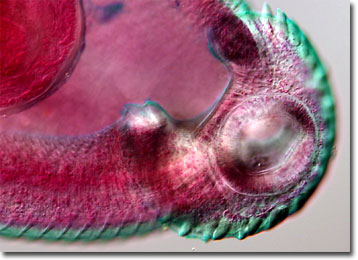Differential Interference Contrast Image Gallery
Digenetic Trematode (Echinostoma)
Echinostoma is a genus of digenetic trematodes belonging to the flatworm phylum Platyhelminthes. The generic name is fittingly derived from the Greek roots for spiny (echino) and mouth (stoma), as its adult members are characterized by a collar of spines, or papillae, around their anterior ends.

The life cycle of digenetic trematodes is complex, involving one or more intermediate hosts and a primary host. The endoparasites of the genus Echinostoma often infect avian species, such as ducks, geese, and pigeons, as well as humans. These animals become contaminated by ingesting raw freshwater snails or frogs that act as intermediate hosts of the trematodes. In their final adult forms, the flatworms use oral and ventral suckers to hold onto the lining of the bird cecum or human rectum. Since these hermaphroditic flukes cannot biosynthesize their own fatty acids and sterols, they must depend on parasitism to fulfill their nutritional needs.
Human symptoms of Echinostoma infestation include weakness, emaciation, and, in serious cases, hemorrhagic enteritis. Some research suggests, however, that digenetic trematode infection may have other effects in different species. Studies in the 1990s, for instance, indicate that the parasites are likely responsible for some cases of limb abnormalities in amphibian populations. The growth of extra digits or duplicate limbs may be a localized response to the mechanical disruption caused by trematodes encysted in the hindquarters of frogs, salamanders, and other amphibians.
